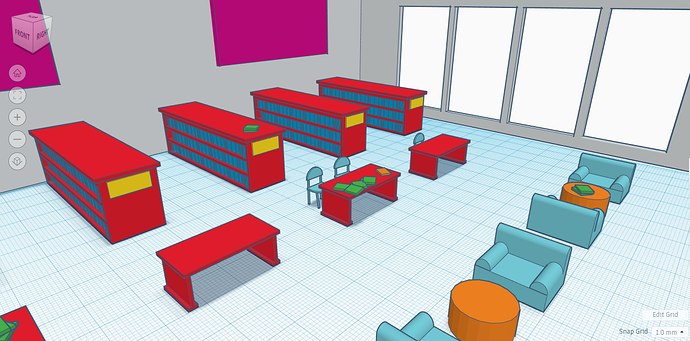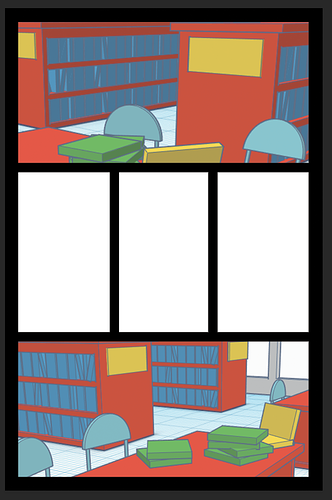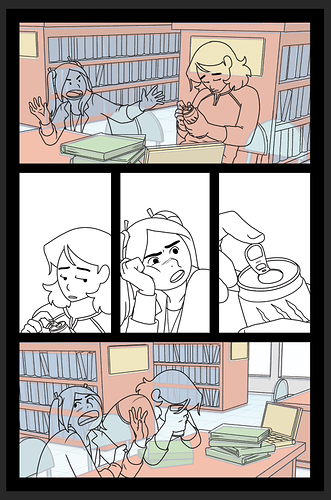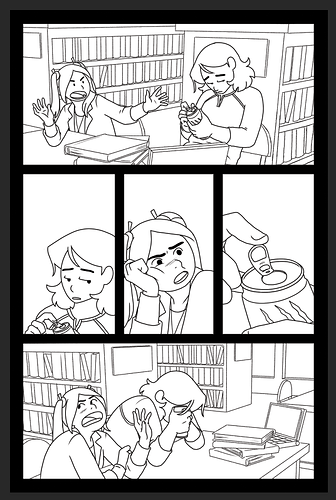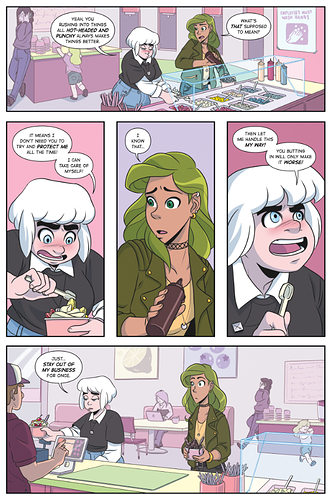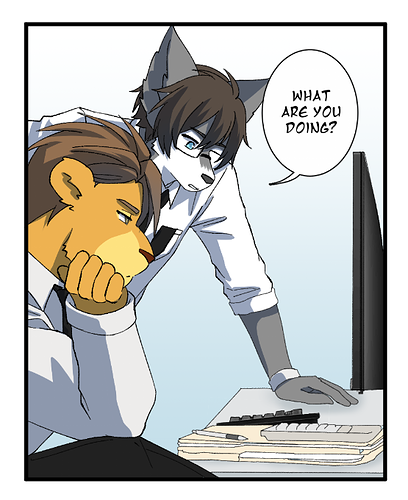My personal favorite time-saving measure is building 3D models of recurring backgrounds, and using those as reference to draw all my backgrounds from. That way I don't have to sit and math out the perspective of a scene, I can just rotate my 3D model to the right camera angle, take a screenshot, and bring it into my drawing program and trace over it.
3D Model
I build my models in TinkerCAD42, which is aimed primarily at children, so it's super easy to use and has a lot of really easy tutorials to walk you through navigating your workspace and creating complex shapes.
Import to Drawing Program
Then, using my thumbnails or pencils as a reference, I rotate and zoom the camera in TinkerCAD to the right position, take a screenshot, and import that into my drawing file. It can take a couple tries to get the angle right sometimes, but I almost always get it right on the first or second attempt.
Trace Over It
Lately I've been using Clip Studio for my backgrounds because I can turn on the perspective rulers, snap my vanishing points to the lines already established in my 3D model, and draw without having to worry about my lines not being in perspective. Serious time saver right there! Then just hide the perspective ruler layer to draw things that don't go to my vanishing points, and it's great.
Done!
Bring it back into Photoshop to draw my characters and finish up the coloring and word balloons and whatnot.
This whole process isn't really necessary for a short scene in one location that will never been seen again, but for a long scene in one place, or a location that the characters keep going back and revisiting, it saves me a ton of time. And I don't build my 3D models very complex, I add most of the detail as I'm inking it in Clip or Photoshop. For example, this scene in a different comic I did...
I did all of my backgrounds from this 3D model I built of a froyo shop...
The model itself is not very detailed at all, but it helped me establish some complicated perspective tricks, especially along the curved wall, and helped me keep everything to scale.
@disqette
My tip is using the tomato timer technique.
When you start to draw, start the timer and stop when the timer stops.
Don't do anything but drawing when the timer starts. Don't check out your social media apps or anything.
Then have a break when the timer ends.
Stand, walk around.
Here is the link:
www.tomato-timer.com7
Please check out my webtoons too:
https://m.webtoons.com/en/challenge/cognitive-dissonance-b/list?title_no=429789&page=1&webtoon-platform-redirect=true5
@ninjashira I'm gonna try to give Sketch Up one more try...I really dont have the patience to learn to use & build enviroments in 3-D programs, but I do see where it can it would help in production. I do use 3-D models in my character poses, which really helps me save time when laying out my pages; I also use 3-D items like furniture and modify them to my specific needs/tastes.
Def like the finish..! 
If I've drawn a complex environment or prop from the rough angle I need once, I usually copy-paste the inks in other panels. you can change the perspective and all sorts using the transform tool in Clip Studio or Photoshop.
Tip for drawing lots of windows or similar repeated objects: Draw one or two, then use that drawing to make a custom brush that draws that thing.
Literal copy and paste entire panels. Ain't nobody gon care.
First panel:
Copy and paste, but redraw the head slightly. Blur out the lion.
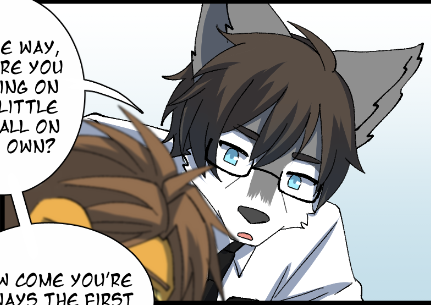
Copy and paste, change expression.
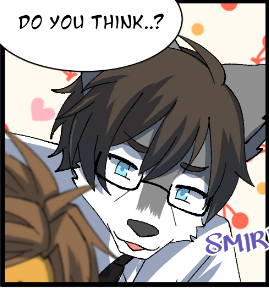
Copy and paste, change redraw the lion and husky's expression.
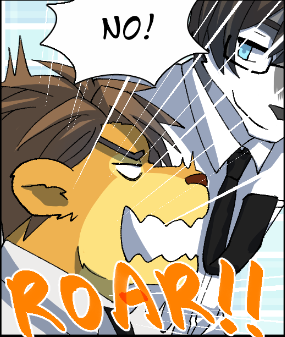
In a 9 panel update, 3 of the panels was just a rehash of the first panel. Different zooms, crops, and panel sizes can disguise the copy pasta buffet.
For my characters, I just copy and paste if the next frame the character doesn't require a complete redraw of the pose. My comic's camera is stationary so I can get away with this. If panel one has the character talk, panel two being silent, and panel three talking again, then I can just draw the first panel, c&p into the second, redraw the face to be silent, c&p to the third, and perhaps change a small detail like having them raise and arm for a bit of dynamism. So far it's worked out just fine but it only works because the camera is stationary.
For backgrounds, I use photographs as a reference. I tried making them from scratch at first but I found it much easier to just use various photographs and redraw aspects from them. It gets the backdrops done faster.
If there are scenes in the comic that take place in the same area but in different angles, I use SketchUp instead of having to just draw each scene from scratch. If there are characters that have the same poses in a few panels, I just copy and paste the line art poses and change the characters' expressions for each panel.
I work in very high resolution (10k pixels) so I can be less pedantic about dropped pixels when I fill colours. Small white areas that don't get filled usually disappear by the time I resize it back down for web.
Working in Clip Studio, that also offers a couple of conveniences I haven't found in other programs (came from Paint Tool SAI, Firealpaca/Medibang)
- various preset balloon shapes, so I can just drag and drop onto my comic when I'm typesetting. CSP also has a really good text function where you can insert text into a balloon shape, and the text will lock to the balloon, allowing you to move both around at the same time with only the balloon selected.
- CSP's vector layers are really good for expediting lineart, you don't have to make sure every stroke is perfect any more and you can just erase stray intersected lines.
- the fill tool in CSP is the best I have used of all the art programs I've used in my career, and it has various other fill tools that help save a lot of time.
- the combination of perspective rulers and 3d models is very powerful in CSP, allowing me to draw complicated angles accurately.
I know this sounds like an advert for Clip Studio LOL, so I'm sorry, but it genuinely is the best drawing software I've ever used in my life, and upgrading to it last year was such a game changer.
I definitely agree with you! I switched over to Clip studio from Procreate/photoshop around a month or so ago and it's been incredible. The assets, custom brushes, the fill tool, etc....all are so amazing and time-saving. I'm still trying to figure out how to do curves on the app version but I've also heard great things about that tool
@sushy00 as you become used to making your comic, you want to figure out ways to use less time in making it- or you're gonna be burned out before you can finish.
CSP just ended a sale Tuesday...I dont think they'll have another one until late August or September that usually coincides with Back to School.
No worries! It does have a pretty intimidating learning curve I think, since it's so feature heavy, but in the end it's worth it.
This tumblr has a lot of really good guides to get you started. https://professorfaf.tumblr.com/post/178043863160/professorfaf-masterpost9
Is this just for art, or is it for writing too? Because I have a few writing tips that can save a ton of time in the long run:
- Name your chapters. If you need to go back and reference earlier material, it is 1000% easier to remember which chapter to go to if you actually have a name to associate it with.
- If you write your story/script in Google docs and find it slow (as most people without a gaming PC do), create a full RTF or .doc file containing your full story and keep that open in Office/Open Office/Wordpad. You can use that to ctrl+f passages, go through your entire manuscript up to that point, and it won't take minutes of loading time to go through.
- Buy and learn to use Scrivener. Regardless of whether you do comics or novels, if you want a comprehensive story document and the ability to organize your work with very little loading time, this program is the best of the best. I have a 300,000 word manuscript and worldbuilding info all in one project file, and it loads chapters pretty much instantly. Plus you can do metadata tagging and keep your outlines organized and all that fun stuff.
- As for actual story-related advice: If you need to get a chapter out quick but words aren't coming out, a technique I like to use is "in medias res opener." Start the chapter in the middle of a conversation, so that the characters are already talking and interacting and you can get right to the meat of the content.

